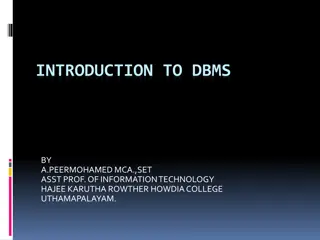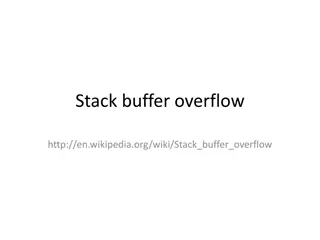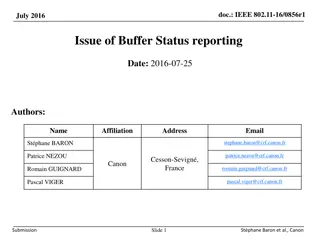Efficient Buffer Management Strategies in Database Systems
Buffer management is a crucial aspect of database systems, ensuring optimal data storage and retrieval. This involves intelligent shuffling of data between memory and disk, guided by replacement policies like LRU and Clock algorithm. Understanding how buffer managers operate and make decisions is key to efficient database performance.
Download Presentation

Please find below an Image/Link to download the presentation.
The content on the website is provided AS IS for your information and personal use only. It may not be sold, licensed, or shared on other websites without obtaining consent from the author.If you encounter any issues during the download, it is possible that the publisher has removed the file from their server.
You are allowed to download the files provided on this website for personal or commercial use, subject to the condition that they are used lawfully. All files are the property of their respective owners.
The content on the website is provided AS IS for your information and personal use only. It may not be sold, licensed, or shared on other websites without obtaining consent from the author.
E N D
Presentation Transcript
Buffer Management Strategies CS 346
Outline CS346-level Buffer Manager Background Three Important Algorithms QLSM Model DBMin Algorithm Experiments
Buffer Managers Buffer manager intelligently shuffles data from main memory to disk: It is transparent to higher levels of DBMS operation
Buffer Management in a DBMS Page Requests from Higher Levels READ WRITE BUFFER POOL disk page free frame INPUT OUTUPT MAIN MEMORY DISK choice of frame dictated by replacement policy DB Data must be in RAM for DBMS to operate on it! Table of <frame#, pageid> pairs is maintained 4
When a page is requested A page is the unit of memory we request If Page in the pool Great no need to go to disk! If not? Choose a frame to replace. If there is a free frame, use it! Terminology: We pin a page (means it s in use) If not? We need to choose a page to remove! How DBMS makes choice is a replacement policy
Once we choose a page to remove A page is dirty, if its contents have been changed after writing Buffer Manager keeps a dirty bit Say we choose to evict P If P is dirty, we write it to disk If P is not dirty, then what?
How do we pick a frame? Needs to decide on page replacement policy Examples: LRU, Clock algorithm, MRU Some work well in OS, but not always in DB more later 7
Least Recently Used (LRU) Order pages by the time of last accessed Always replace the least recently accessed P5, P2, P8, P4, P1, P9, P6, P3, P7 Access P6 P6, P5, P2, P8, P4, P1, P9, P3, P7 LRU is expensive (why ?) 8
The Clock Approximation Instead we maintain a last used clock Think of pages ordered 1 N around a clock The hand sweeps around Pages keep a ref bit Whenever a page is referenced, set the bit If current is has ref bit == false choose it If current is referenced, then unset ref bit and move on Approximates LRU since referenced pages less likely
MRU Most Recently Used. Why would you ever want to use this? Hint: Consider scanning a relation that has 1 Mn pages, but we only have 1000 buffer pages This nasty situation is called Sequential Flooding. Each page request causes an I/O.
Simplified Buffer Manager Flowchart What if all pages are pinned? Request a Page Dirty Flush P to Disk Find a page P that is unpinned according to policy. Return Frame handle to caller
Doesnt the OS manage Pages too? Portability: Different OS, Different support Journaling, nothing, something crazy Limitations in OS: files cannot span disks. DBMS requires ability to force pages to disk Recovery (much later) DBMS is better able to predict page reference patterns Prefetching is harder
Buffer Management Summary Page Requests from Higher Levels READ WRITE BUFFER POOL disk page free frame INPUT OUTUPT MAIN MEMORY DISK choice of frame dictated by replacement policy DB Data must be in RAM for DBMS to operate on it! Table of <frame#, pageid> pairs is maintained 13
3 Important Algorithms (and ideas)
(I) Domain Separation (Reiter 76) Separate pages into statically assigned domains If page of type X is needed, then allocate in pool X LRU in each Domain If none are available in current domain, then borrow 1: Root 2: Internal Nodes 3: Leaves
Pros and Cons Pro: Big observation. Not all pages are the same! Con 1: Concept of domain is static Replacement should depend on how page is used E.g., a page of a relation in a scan v. a join Con 2: No priorities among domains Index pages more frequently used than data pages Con 3: Multiuser issues. No load control Multiple users may compete for pages and interfere
(II) New Algorithm Two Key Observations 1. The priority of a page is not a property of the page; in contrast, it is a property of the relation to which that page belongs. 2. Each relation should have a Working Set Separate Buffer pool by relation Each relation is assigned: 1. Resident Set of Pages (MRU) 2. A small set exempt from replacement consideration
Resident Sets Free Pages List MRU, Rel 1 Search through, top-down MRU, Rel 2 Intuition: - If near the top, then unlikely to be reused. - If near the bottom then pages are protected.
Pros and Cons of Resident Sets MRU only in limited cases. When? How do you order the resident sets? Heuristic based (one could imagine some stats) Searching through list may be slow Multiuser? How do we extend this idea to work for multiple users?
(III) Hot Set Observation A hotset is a set of pages that an operation will loop over many times. LRU Nested Loop Join Hotset = 1 + |S|. Why? # Page Faults MRU Model is tied to LRU Hot point # Buffers
Hotset Drawbacks The model is tied to LRU but LRU is awful in some cases. Where? What can be cheaper than LRU and (sometimes) as effective?
Quiz 1. How does the buffer pool in a database differ from what you d find in an OS? 2. When is MRU better than LRU? 3. Suppose you have a single buffer pool with N pages. Suppose that |R| = M pages and |S| = N+1 pages. How many IOs do you incur? (hint: what buffer policy do you use?)
Motivation for QLSM 1. Want to understand that pages should be treated differently. (from Reiter) 2. Want to understand that where a relation comes from matters 3. Want to understand that looping behavior (hot sets) makes a big difference 1. And is predictable!
QLSM. Main Insights Query Locality Set Model Database access methods are predictable handful of macro So, define a handful of reference access methods We don t need to tie it to LRU.
Example Consider an index nested loop join with an index on the joining attribute. Two locality sets: 1. The index and inner relation 2. The outer relation.
Handful of References. Sequential. Sequential References: Scanning a relation. 1. Straight Sequential (SS). Only one access without repetition. - How many pages should we allocate? 2. Clustered Sequential (CS). Think Merge Join - What should we keep together? 3. Looping Sequential (CR). Nested loop Join. - What replacement policy on inner?
Random Random References. 1. Independent Random. Example? 2. Clustered Random. - Clustered inner index, outer is clustered - Indexes are non-unique. (Similar to CS)
Hierarchical Straight Hierarchical: B+Tree Probe (X = 10) Hierarchical + Straight Sequential (X >= 10) Hierarchical + Cluster Sequential (X>= 10) Looping Hierarchical: Index-Nested Loop Join Inner relation has the index.
Discussion Do you believe this taxonomy is complete? To what extent is it complete? Could you build a similar taxonomy of operations for Java programs?
DBMin Buffers are managed on a per file instance Active instances of the same file are given different buffer pools and may use different replacement policies! Files share pages via global table Set of buffered pages associated with a file instance is called its locality set Replacement Policy (RP) of a buffer simply moves to Global Free list (not actual eviction!) How are concurrent queries supported?
Search Algorithm Cases Case I: page in both global table and locality set of requesting process Simply update stats (of RP) and return Case II: Page in memory, but not in locality set If page has an owner, then simply return it O.w., page is allocated to requestor s LS Could cause an eviction to free page list Case III: Page not in memory. Bring it in, proceed as in case II. Q: How could a page be in memory and not have an owner?
DBMins Load Controller Activated when a file is opened or closed Checks whether predicted locality set would fit in the buffer. If not, suspend query. How does the LC know how big the locality set is?
Estimating Locality Set Size/Policy Question: How big is the locality set? What is the policy? Straight Sequential (one-off scan) Clustered Sequential Independent Random If sparse, go for either 1 or b. Policy? If not, could upper bound using Yao s formula Looping Hierarchical Root traversed children more frequently If cannot hold a entire level, access may look random So, 3-4 pages may suffice (more now)
Algorithm Highlights/Summary Different pages used in different ways A page meritocracy! Classification and Taxonomy Allows us to use better replacement policy Big wins with right policy Sharing of pages through global table Local replacement policy just puts on global free Load control is built in
Questions to Reinforce the Material Working Set does not perform well on Joins. Why? With a load-controller, every simple algorithm outperforms WS. What does the load controller prevent? Is it reasonable to build such a load- controller?
Further Reading (Papers I like) Elizabeth J. O'Neil, Patrick E. O'Neil, Gerhard Weikum: The LRU-K Page Replacement Algorithm For Database Disk Buffering. SIGMOD Conference 1993: 297-306 Goetz Graefe: The five-minute rule 20 years later (and how flash memory changes the rules). Commun. ACM 52(7): 48-59 (2009) Jim Gray, Gianfranco R. Putzolu: The 5 Minute Rule for Trading Memory for Disk Accesses and The 10 Byte Rule for Trading Memory for CPU Time. SIGMOD Conference 1987: 395-398























